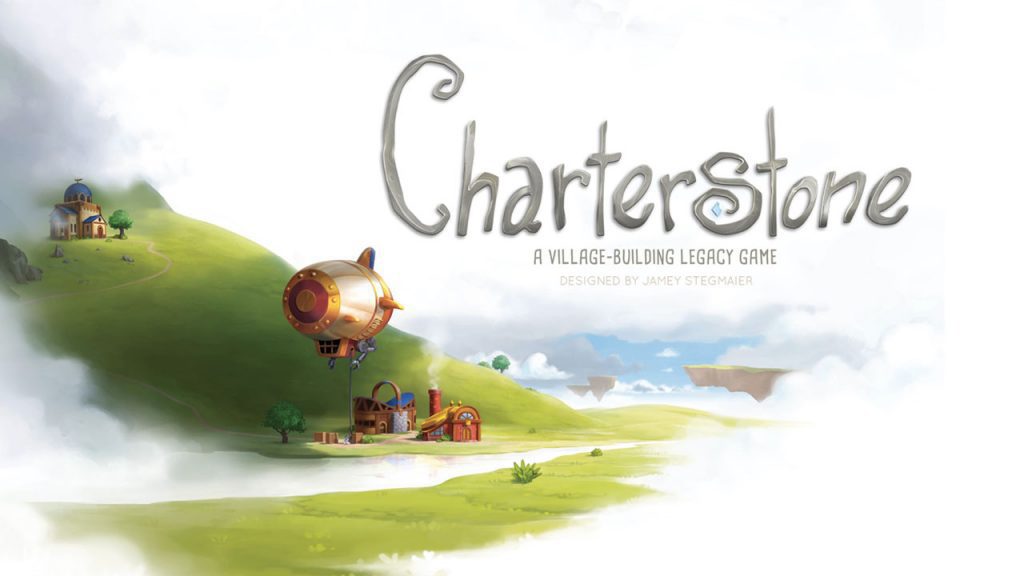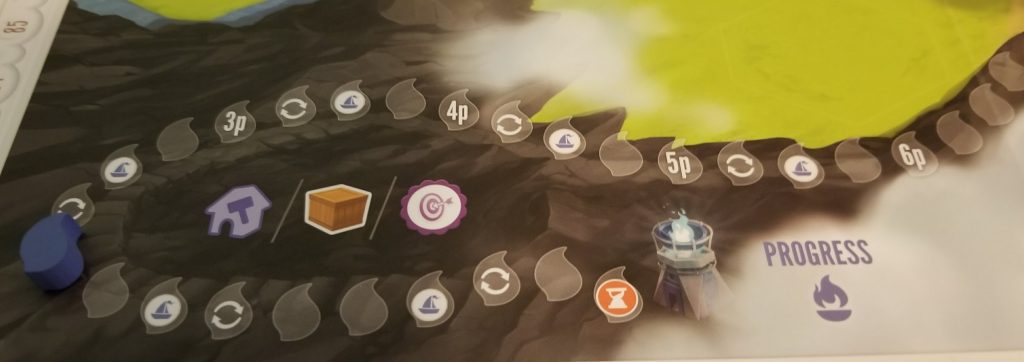If you’re looking to learn how to play the game, read our full Charterstone review. Here, we compare the spoiler-free thoughts of 5 Meeple Mountain authors who played through different campaigns.
Kurt Refling
4 Players
No Automa
I want to be generous. Here’s the best I have: Charterstone is not a broken game.

Taken for what it is, Charterstone has gathered a group of familiar mechanics and tied them together with the promise of an overarching meta-game. Worker placement, tile placement, resource management, even a sprinkle of area control– they’re all coexisting comfortably within the friendly-looking box. It has taken these things and made a legacy game. It works.
But I don’t like it.
Somewhere between the glimpses of a story that always felt distant and the games that seemed to go on just a little bit too long, Charterstone lost me. No magic moment took hold. For any other game, this is pretty forgivable: a handful of mediocre worker placement sessions are a long way from the end of the world, and I can tolerate a euro game that’s a touch too beige. But Charterstone asks more.
A legacy game is a commitment. There’s an expectation that, every session, you’ll show up with a smile to continue the campaign. Now, you can accuse me of grading on a curve, but I feel like if you’re asking me to play a game a dozen times there’s gotta be something special. With Charterstone, I don’t think there is.
I feel a little bad writing a negative review without a strong rationale of what went wrong, but… well, here we are. Long (long) story short: Charterstone felt like a guest that overstayed their welcome on Day 1, then stuck around for another week. The post-campaign game looks more interesting than my core experience, but I know I’m never going to play it. As another Kurt once said– so it goes.
Read more from Kurt Refling.
Ashley Gariepy
4 Players (with one replacement player as of game 8)
No Automa
I went into Charterstone with no expectations since I felt there was no way that this game could ever live up to Pandemic Legacy (which I absolutely loved). I would have even written it off completely had I not found the game on sale. At the end of our campaign, I was pleased with the experience overall and I was glad to have played it.
Our games played rather quickly and there wasn’t much downtime between player turns. The two most successful players focused heavily on building in the beginning of the campaign. After constructing some high-point buildings, these two players (who ended up scoring first and second in the campaign) were able to focus their strategy on creating a synergy between their buildings, player pieces, and cards each game to earn bonuses for each worker placement or for worker retrieval.
I was one of the two players to use this strategy so each game felt meaningful and fun as I tried to maximize my points using my engine. I enjoyed trying to balance whether I wanted to win the game or simply do well, but achieve the guidepost and control the decision made at the game’s end. For me, everything clicked from game-to-game and even when I didn’t win, I felt good about how I had played.

I wish the story had been a little more exciting, but that didn’t stop me from feeling quite invested in my charter and its starting persona– so much so that I was upset when I chose to discard a building with a crate and, in a later game, another player opened it, gaining control of my character. I also wish that the campaign had been cut down to 10 games instead of 12 because there was a point where the gameplay felt a little repetitive before we had unlocked some cool new stuff.
Despite enjoying the gameplay experience overall, I wouldn’t play another Charterstone campaign. I am, however, curious to see how the game will play post-campaign…but I’m hesitant to let anyone else play my beautifully crafted charter.
Read more from Ashley Gariepy.
David McMillan
2 Players
Some Automa
When my wife, Jennifer, and I first started playing Charterstone, we’d never played a legacy game before. The thought of playing a game and having to tear it up as you went along was always a huge turnoff for us. But Charterstone promised something else no other legacy game out there could claim: a fully replayable game when all was said and done. Knowing this, we didn’t hesitate to buy it and we immediately jumped in with both feet. The feeling that we got from playing the game was mixed – part elation, part dissatisfaction.

The thrill of unlocking new game elements and exploring new mechanics was exciting for us. It’s a game that incentivizes building an engine and then using that engine to grind out as many victory points as possible before the game’s built-in timer brings each session to an end. Being heavy euro-gamers, this aspect of Charterstone really spoke to us. We were enjoying spending time together and we weren’t in any rush for everything to end. As far as that goes, Charterstone’s a fine game and there’s plenty of opportunity for players to explore this engine building aspect.
However, I’d wager that our negative experiences probably outweigh what was mostly a positive one. Around game 3, we decided to try playing with the Automa and that turned out to be a huge mistake. The Automa are controlled by a deck of cards and a lot of these cards will cause the aforementioned game timer to move forward a step. This caused us some consternation because the rapid fast-forwarding of the game prevented us from getting our victory point engines up and running. We went from an average of 50+ points per game to less than 20 apiece. We only used them for three games, but playing with the Automa is something that we will always regret. I wouldn’t recommend using them ever.

We’re giving the game another shot, though. Currently, Jennifer and I are at the midpoint of a 3 player campaign (our second playthrough overall). We’re being much more careful this time around with what we build and where we build it and definitely avoiding the dreaded Automa. So far, so good. We’re having a blast.
Read more from David McMillan.
Justin Gibbons
2 player
No automa
Whereas David decided to add in the Automa, my wife Kai and I decided to play the entire campaign as a strictly two player game (no Automa). We felt this presented some great benefits, but not without its own small downsides.
We are both familiar with worker placement and legacy games so it was a no-brainer for this to hop to the top of our “must buy” chart(er). Give me things to sharpie and tear up all day, David! I mean how often do you get to commit acts of violence against board game components and it be part of the game!? Disturbing impulses aside, the art hooked us and the gorgeous presentation had us diving in immediately.

And after our first game we thought “that was it?” As a two-player game, the first couple of scenarios went by lightning fast. The game amounts to not much more than drop a worker, collect something, next player goes. Rinse and repeat. There’s not too much to do in your first few games until you start unlocking rules and new components. By the end of game three I was getting very nervous. It didn’t seem like there was much “meat” to go along with my iron bars and gold coins.
By game four things started to turn. We had experienced a bit more of the “story” at that point and had unlocked some components that vastly improved the decision-making department. And the game consistently improved from there. These days, I always tell people to hang in there until game four to decide if it’s for you.
Unlike Kurt, our games were lightning fast. There was not a single game that lasted over 40 minutes. One game only lasted 10. Since you’re only paying attention to each other’s progress, and there are fewer workers interfering with the board, it’s wide open for you to rapidly place-and-grab. And whereas David’s initial games focused on engine building, Kai and I always prioritized the mission objective over engine building, which ends the games quickly.

With two players, you can fly through the campaign faster than a CMON Kickstarter meets its funding goal. Well maybe not THAT fast. But it did leave us with a bit of longing to try the Automa! The campaign ending came almost too quickly and we felt there was not much to savor. Sure we can go back and play our finished board, but we are interested in seeing how much it changes when “opponents” are working against you. That said, while it wasn’t as mind-blowing as other legacy games, or as meaty as other worker placement games, it gave us enough in both of those categories to create many enjoyable nights of gaming.
Read more from Justin Gibbons.
Kathleen Hartin
4 Players
No Automa
I quite like Jamey Stegmaier so I was excited to play a legacy game of his creation. As a worker placement game, Charterstone is solid. As a legacy game, it lacks momentum. For the first half of the campaign, I won every game. It seems like once you find the right strategy in Charterstone, there’s not much competing with it. Sometimes I wouldn’t even try to win because other goals seemed more important, and it would still happen. Then the winds changed. I was the red player, and red was going strong until yellow found a slightly better strategy. And then no one could compete with them. Well that’s not entirely true; we could have, but half of the players (myself included) didn’t like the strategies that prolonged the game so we didn’t. Our best games (most enjoyable) were the ones that went by quickly. Yellow’s best games (most enjoyable and the ones he won) went on forever. So long in fact that it made some of the players unexcited to finish the campaign. Green and blue each won one game, but other than those two it was between me and yellow. We were a group of experienced board gamers, and no one should have been at a disadvantage, but some cards allowed for such a powerful strategy that other players couldn’t really compete.

Because of this predictability, I never really felt compelled to play again. I knew who would win and I knew what strategies would be used. As far as the legacy components went, there was never anything that really threw a wrench in that predictable chain of events. I want a legacy game to make me excited to see what comes next, but as it turned out what came next was just more of the same.
All-in-all, did I like it? Yes. Would I buy the recharge pack and start again? Definitely not. I could see myself playing it again in the future as a one-off worker placement game now that we’ve completed the map, but I’m in no hurry to.
Read more from Kathleen Hartin.












Add Comment